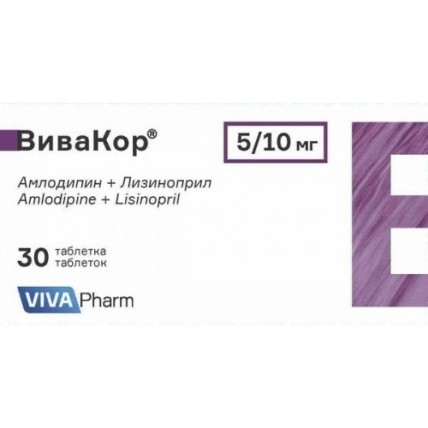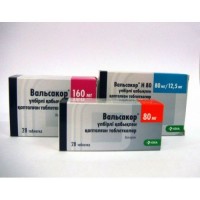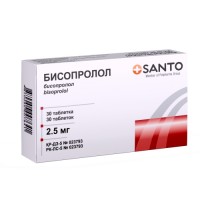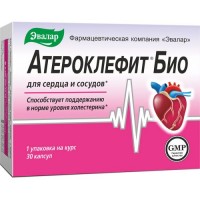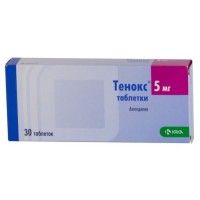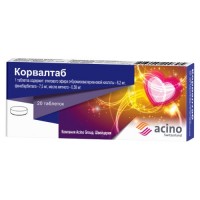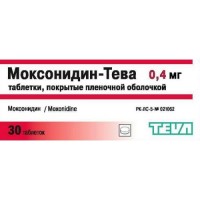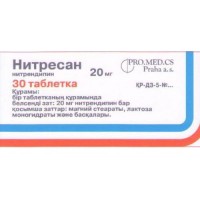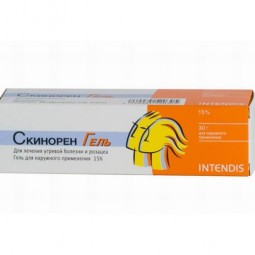The instruction for medical use of VivaKor® medicine the Trade name of VivaKor® the International unlicensed name Is not present the Dosage form of the Tablet, 5/5 mg, 5/10 mg and 10 mg / 20 mg Structure One tablet contains active agents: an amlodipina besilat 6.94 mg or 13.88 mg (in terms of dry matter amlodipin 5 mg or 10 mg), lisinopril a dihydrate of 5.44 mg, 10.88 mg or 21.76 mg (in terms of dry matter lisinopril of 5 mg, 10 mg or 20 mg), excipients: starlak (mix of 85% of lactose of monohydrate and 15% of starch corn), sodium starch is glikolit, aerosil, magnesium stearate. The description of the Tablet of round shape with a biconvex surface of white or almost white color (for a dosage of 5/5 mg). Tablets of round shape with a biconvex surface of white or almost white color (for a dosage of 5/10 mg). Tablets of round shape with a biconvex surface of white or almost white color (for a dosage of 10/20 mg). Pharmacotherapeutic group the Drugs influencing a system renin-angiotensin. APF inhibitors in a combination with other drugs. APF inhibitors in a combination with blockers of slow calcium channels. Lisinopril and amlodipin. The ATX C09BB03 code the Pharmacological Pharmacokinetics Lisinopril Absorption Later properties of intake the maximum concentration of lisinopril in blood serum are observed approximately in 7 hours, at the same time the tendency to insignificant increase in time of achievement of the maximum concentration in blood serum at patients with an acute myocardial infarction was noted. On the basis of data on removal with urine the average extent of absorption of lisinopril makes about 25%, the variability at different patients is from 6 to 60% in the studied dose range (from 5 to 80 mg). At patients with heart failure the absolute bioavailability of lisinopril decreases approximately to 16%. Absorption of lisinopril does not depend on meal. Distribution and linking with proteins Lisinopril does not contact serum proteins, except for the circulating angiotensin-converting enzyme (APF). Practically does not get through a blood-brain barrier. Removal Lisinopril is not exposed to metabolism and is removed with urine in not changed look. At repeated use of lisinopril the effective elimination half-life makes 12.6 hours. The clearance of lisinopril at healthy volunteers is about 50 ml/min. Decrease in concentration in blood serum has the prolonged terminal phase that does not promote accumulation of drug in an organism. This terminal phase probably represents saturable linking with APF and is disproportionate to a dose. The Liver failure the Abnormal liver function at patients with cirrhosis led pharmacokinetic characteristics at special groups of patients to decrease in absorption of lisinopril (approximately for 30% according to data on removal with urine), however influence of drug increased (approximately by 50%) in comparison with healthy volunteers because of decrease in clearance. The renal failure the Renal failure reduces removal of lisinopril which is removed through kidneys, but this decrease becomes clinically significant only when glomerular filtration rate is less than 30 ml/min. In a slight and moderate renal failure (clearance of creatinine from 30 to 80 ml/min.), the average AUC value increases only by 13% while in a heavy renal failure (clearance of creatinine from 5 to 30 ml/min.) the increase in average AUC value by 4.5 times is observed. Lisinopril can be removed from an organism by means of a hemodialysis. After 4 hours of a hemodialysis of concentration of lisinopril in blood plasma decreased on average by 60%, and the dialysis clearance was from 40 to 55 ml/min. Heart failure Patients with heart failure have high concentration of lisinopril in blood plasma in comparison with healthy volunteers (increase in AUC on average by 125%), but on the basis of data on removal with urine, absorption of lisinopril at them decreases approximately by 16% in comparison with healthy volunteers. Patients of advanced age At patients of advanced age are observed higher concentration of lisinopril in plasma of blood and higher values for the area under a curve concentration in blood plasma - time (about 60 percent more) in comparison with younger participants of a research. Amlodipin Vsasyvaniye After intake amlodipin is well soaked up, the maximum concentration in blood plasma are reached in 6-12 hours after administration of drug. The absolute bioavailability is from 64 to 80% by estimates. Meal does not affect bioavailability of an amlodipin. Distribution and linking with proteins of plasma the Volume of distribution makes about 21 l/kg. The researches in vitro showed that about 97.5% of the circulating amlodipin are connected with proteins of plasma. Biotransformation and removal Terminal plasma elimination half-life makes about 35-50 hours and corresponds to administration of drug once a day. Amlodipin is exposed to intensive metabolism in a liver with formation of inactive metabolites, at the same time 10% of initial connection and 60% of metabolites are removed with urine. Pharmacokinetic characteristics at special groups of patients Use for patients with a liver failure Clinical data on use of an amlodipin for patients with a liver failure are very limited. At patients with a liver failure the clearance of an amlodipin is reduced that leads to increase in elimination half-life and increase in AUC approximately by 40-60%. Patients of advanced age Time of achievement of the maximum concentration of an amlodipin in blood plasma at elderly and younger participants of a research almost identical. The tendency to decrease in clearance of an amlodipin is observed that leads to increase in AUC and elimination half-life at elderly patients. Increase in AUC and elimination half-life at patients with stagnant heart failure met expectations for the studied age group. The combined drug with the fixed dose pharmacokinetic interactions between active components of the drug VivaKor® are not described. Pharmacokinetic parameters (AUC, Cmax, tmax, t1/2) did not differ from those after administration of active components separately. Meal does not influence absorption of drug in a GIT. The pharmacodynamics Lisinopril Lisinopril represents peptidildipeptidaza enzyme inhibitor. It inhibits angiotensin-converting enzyme (APF) which catalyzes transformation of angiotensin I into vasopressor peptide, angiotensin II. Angiotensin II also stimulates secretion of Aldosteronum with bark of adrenal glands. The inhibition of APF leads to decrease in concentration of angiotensin II therefore the angiotonic activity decreases and secretion of Aldosteronum decreases. Decrease in the last can lead to increase in content of potassium in blood serum. As it is considered that at the heart of the mechanism by means of which lisinopril reduces arterial blood pressure, first of all, oppression system renin-angiotensin-aldosteronovoy lies, lisinopril reduces arterial blood pressure even at patients with arterial hypertension with the low level of renin. APF is identical to a kininaza of II, enzyme which destroys bradykinin. In comparison with a blocker of calcium channels which caused the same lowering of arterial pressure at the patients receiving lisinopril the bigger decrease in excretion of albumine with urine was revealed considerably that demonstrates that lisinopril APF-inhibiting effect, in addition to antihypertensive effect, also reduced a microalbuminuria direct impact on tissues of kidneys. Treatment by lisinopril does not influence control of a glycemia that is confirmed by lack of considerable influence on levels of glikozilirovanny hemoglobin (HbA1c). Amlodipin Amlodipin is a dihydropyridinic inhibitor of receipt of calcium ions (a blocker of slow calcium channels or the antagonist of calcium ions), blocks their receipt through membranes in muscle cells of a myocardium and vessels. The mechanism of antihypertensive action of an amlodipin is caused by the direct weakening impact on unstriated muscles of vessels. Reception of an amlodipin daily leads once a day to clinically significant lowering of arterial pressure at patients with arterial hypertension both in vertical, and in horizontal position within 24 hours. Owing to the slow beginning of action the fast hypotensive effect does not occur. Amlodipin has no adverse impact on a metabolism or concentration of lipids of blood plasma and can be applied at treatment of patients with bronchial asthma, diabetes 2 types and gout. Indications - essential arterial hypertension - as an alternative to a concomitant use of lisinopril and an amlodipin in the specified doses providing adequate control of arterial blood pressure at adult patients. A route of administration and doses the Drug should be taken orally, without chewing and without crushing a tablet, irrespective of meal. The recommended dose - one tablet of the drug VivaKor® (5/5 mg, 5/10 mg, 10 mg / 20 mg) daily. Duration of treatment and a dose of the drug VivaKor® is established by the doctor. The maximum daily dose - one tablet of the drug VivaKor® (according to the appointed dosage of 5/5 mg, 5/10 mg, 10 mg / 20 mg). In need of dose adjustment it is possible to consider expediency of selection (titration) of a dose with individual components. Patients with a renal failure at patients with a renal failure the titration of doses should be made For selection of an optimum initial dose and a maintenance dose individually, using separate components of drug – lisinopril and amlodipin. During therapy by the drug VivaKor® it is necessary to control function of kidneys, content of potassium and sodium in blood serum. In case of deterioration in function of kidneys it is necessary to stop administration of drug and to replace them with the individual components which are picked up properly. Amlodipin is not brought by means of dialysis. Patients with a liver failure of the Recommendation concerning doses at patients with a slight or moderate liver failure are not developed yet therefore such patients should carry out selection of doses with care, and it is necessary to begin with the minimum dose in the dosing range. At patients with a liver failure the titling of doses should be made for selection of an optimum initial dose and a maintenance dose individually, using a free combination of lisinopril and an amlodipin. The pharmacokinetics of an amlodipin in a heavy liver failure was not investigated. Use of an amlodipin for patients with a heavy liver failure should be begun with the lowest dose, at the same time titling should be made slowly. Patients of advanced age (& gt, 65 years) At patients of advanced age drug should be used with care. The drug VivaKor® can be taken regardless of meal (in time or after a meal) as meal does not influence absorption. Side effects Often (from ≥ 1/100 to & lt, 1/10) - dizziness, a headache, drowsiness, increased fatigue - a cardiopalmus, orthostatic hypotension - the dry cough stopping at drug withdrawal - diarrhea, nausea, vomiting, an abdominal pain - a renal failure - peripheral swell, swelled anklebones, a dermahemia Infrequently (from ≥ 1/1,000 to & lt, 1/100) - a sleep disorder, insomnia, change of mood (including uneasiness), a depression, an asthenia, an indisposition - paresthesias, hypesthesias, vertigo, a tremor, a syncope, a dysgeusia - visual disturbances (including. diplopia) - sonitus - tachycardia, arterial hypotension, a myocardial infarction and disturbance of cerebral circulation, it is probable as a result of excessive arterial hypotension at patients of group of high risk, Reynaud's syndrome - short wind - a dorsodynia, arthralgias, myalgias, tonic spasms in muscles - rhinitis - dryness in a mouth, dyspepsia, defecation change (diarrhea, constipations) - an itching, skin rashes, an alopecia, a purpura, discoloration of skin, the increased sweating, a dieback - urination disorder (including the speeded-up urination), a nocturia - impotence, a gynecomastia - increase in concentration of creatinine, urea in blood serum, a hyperpotassemia, increase in activity of hepatic enzymes - increase or decrease in body weight Is rare (from ≥ 1/10,000 to & lt, 1/1,000) - a syndrome of inadequate secretion of antidiuretic hormone - confusion of consciousness, disturbance of mentality - psoriasis, urticaria, hypersensitivity / a Quincke's disease of the face, extremities, lips, an epiglottis and a throat, language - an acute renal failure, uraemia - insignificant decrease in hemoglobin and a hematocrit at prolonged use of drug, a hyperbilirubinemia, a hyponatremia Very seldom (& lt, 1/10,000) - oppression of a marrowy hemopoiesis: an agranulocytosis, a leukopenia, a neutropenia, thrombocytopenia, hemolytic anemia, anemia, limfoadenopatiya - autoimmune disorders - a hypoglycemia, a hyperglycemia - peripheral neuropathy, a hyper tone - arrhythmias (in that ventricular tachycardia, bradycardia, fibrillation of auricles), a vasculitis - a bronchospasm, an allergic alveolitis, eosinophilic pneumonia, sinusitis - an intestinal Quincke's disease - pancreatitis, gastritis, a hyperplasia of gums - hepatocellular or cholestatic jaundice, hepatitis, a liver failure - a toxic epidermal necrolysis, Stephens-Johnson's syndrome, a multiformny erythema, exfoliative dermatitis, a vulgar bladderwort, photosensitivity, a skin pseudo-lymphoma, a Quincke's edema - an oliguria/anury data that the syndrome of a pseudo-lymphoma of skin can include one or more of below the listed symptoms Are obtained: fever, a vasculitis, myalgia, arthralgia/arthritis, increase in level of antinuclear antibodies (ANA), increase in the blood sedimentation rate (BSR), an eosinophilia and a leukocytosis, rash, a photosensitization or other changes from skin. At use of an amlodipin, exceptional cases of developing of an extrapyramidal syndrome are also registered. Contraindications - hypersensitivity to lisinopril or other APF inhibitors - hypersensitivity to an amplodipin or other derivatives of dihydropyridines - hypersensitivity to auxiliary components of drug - the profound arterial hypotension - a Quincke's disease against the background of therapy by APF inhibitors - a hereditary or idiopathic Quincke's disease - obstruction of an output path of a left ventricle (heavy degree of an aortal stenosis), a stenosis of the mitral valve / a hypertrophic cardiomyopathy - shock (including cardiogenic shock) - hemodynamically unstable heart failure after an acute myocardial infarction - pregnancy and the period of a lactation - children's and teenage age up to 18 years (because of insufficiency of data on safety and efficiency) - simultaneous use of the drug VivaKor® with aliskirensoderzhashchy drugs at patsiyet with diabetes or a renal failure (SKF & lt, 60 ml/min. / 1.73 sq.m) the Medicinal interactions of Interaction connected with lisinopril Double blockade the system renin-angiotensin-aldosteronovoy (SRAA) Data of clinical trials showed in the anamnesis that double blockade the system renin-angiotensin-aldosteronovoy (SRAA) by combined use of iAPF, the SCONCE of II or an aliskirena is associated with the increased risk of developing arterial hypotension, a hyperpotassemia and renal failures (including an acute renal failure) in comparison with monotherapy. Diuretics At addition of diuretic to therapy by lisinopril, the antihypertensive effect usually amplifies. At the patients receiving diuretics and especially at those to whom treatment by diuretics was recently appointed at addition to lisinopril therapy the excessive lowering of arterial pressure occasionally can be observed. The possibility of symptomatic hypotension at intake of lisinopril can be minimized by cancellation of diuretic prior to treatment by lisinopril. Kaliysoderzhashchy nutritional supplements, kaliysberegayushchy diuretics or kaliysoderzhashchy substitutes of salt In spite of the fact that in clinical trials the potassium content in blood serum usually remained within normal values, at some patients observed
s a hyperpotassemia. Risk factors of development of a hyperpotassemia: renal failure, diabetes 2 types and concomitant use of kaliysberegayushchy diuretics (such as Spironolactonum, Triamterenum or amiloride), kaliysoderzhashchy nutritional supplements or kaliysoderzhashchy substitutes of salt. Use of kaliysoderzhashchy nutritional supplements, kaliysberegayushchy diuretics or kaliysoderzhashchy substitutes of salt, especially at patients with pochenochny insufficiency, can lead to substantial increase of content of potassium in blood serum. If lisinopril is appointed along with potassium - not preserving diuretic, the hypopotassemia induced by intake of diuretic can decrease. Lithium drugs At a concomitant use of drugs of lithium and APF inhibitors were noted reversible increase in concentration of lithium in blood serum and toxicity. The concomitant use of thiazide diuretics can increase risk of development of lithium toxicity and enhance already increased lithium toxicity against the background of use of APF inhibitors. Simultaneous use of lisinopril and drugs of lithium is not recommended, but in case of the proved need of use of this combination, it is necessary to control carefully lithium content in blood serum. Non-steroidal anti-inflammatory drugs (NPVP), including acetylsalicylic acid ≥ 3 g/day Prolonged use of NPVP can reduce antihypertensive effect of APF inhibitor. NPVP and APF inhibitors render additive effect on increase in content of potassium in blood serum and can lead to deterioration in function of kidneys. Such effects usually are reversible. In rare instances the acute renal failure can develop, especially patients with risk of development have renal failures (patients of advanced age or the dehydrated patients). Gold drugs Nitritoidny reactions (vazodilatation symptoms, including hyperaemia, nausea, dizziness and arterial hypotension which can be very heavy) after administration of the injection drug containing gold (for example, aurotiomalat sodium), were registered more often at the patients receiving treatment by APF inhibitors. Other antihypertensive drugs the Concomitant use of the specified drugs can increase hypotensive effect of lisinopril. The concomitant use of lisinopril with glitseriltrinitraty (nitroglycerine) and other nitrates or other vazodilatator can reduce arterial blood pressure even more. (Neuroleptics) / anesthetics the Concomitant use of some anesthetics, tricyclic antidepressants and anti-psychotics with APF inhibitors can lead tricyclic antidepressants / anti-psychotics to a further lowering of arterial pressure. Sympathomimetics Sympathomimetics can reduce antihypertensive effect of APF inhibitors. Hypoglycemic drugs Epidemiological researches showed that the concomitant use of APF inhibitors and hypoglycemic drugs (insulin, hypoglycemic drugs for intake) can enhance hypoglycemic effect with risk of development of a hypoglycemia. Development of this phenomenon is most probable within the first weeks of treatment by a combination of drugs and also at patients with a renal failure. Acetylsalicylic acid, trombolitik, beta blockers, nitrates Lisinopril can be applied along with acetylsalicylic acid (in cardiological doses), trombolitika, beta blockers and/or nitrates. Significant increase in concentration of an amlodipin can cause the interactions connected with amlodipiny CYP3A4 isoenzyme Inhibitors the Concomitant use of an amlodipin with powerful or moderate inhibitors of an isoenzyme CYP3A4 (protease inhibitors, antifungal drugs of group of azoles, macroleads, such as erythromycin or klaritromitsin, verapamil or diltiazem). Elderly people can have more expressed clinical picture of such variations of pharmacokinetic parameters. In this regard careful medical observation and dose adjustment can be required. CYP3A4 isoenzyme inductors the Data concerning influence of inductors of an isoenzyme of CYP3A4 on amlodipin no. A concomitant use of inductors of an isoenzyme of CYP3A4 (for example, rifampicin, the St. John's wort of made a hole (Hypericum perforatum) can reduce concentration of an amlodipin in blood plasma. It is necessary to appoint with care amlodipin along with CYP3A4 isoenzyme inductors. Reception of an amlodipin with grapefruit or grapefruit juice is not recommended as at some patients the bioavailability can increase and thereof, to amplify hypotensive effect. Dantrolen (infusion) After intake of verapamil and intravenous administration of a dantrolen the development of fibrillation of ventricles with a lethal outcome and cardiovascular insufficiency, along with a hyperpotassemia was observed. Because of risk of a hyperpotassemia, it is recommended to avoid simultaneous use of blockers of calcium channels, such as amlodipin, at the patients predisposed to a malignant hyperthermia and receiving treatment concerning a malignant hyperthermia. Influence of an amlodipin on other medicines Hypotensive effect of an amlodipin enhances the corresponding effects of other medicines having antihypertensive properties. In researches of clinical interactions amlodipin did not influence pharmacokinetics of an atorvastatin, digoxin, warfarin or cyclosporine. Simvastatin and 80 mg of a simvastatin led the Concomitant use of repeated doses of 10 mg of an amlodipin to increase in concentration of a simvastatin by 77% in comparison with the corresponding concentration at monotherapy simvastatiny. The dose of a simvastatin at the patients accepting amlodipin should be limited to 20 mg a day. The special instructions Connected with lisinopril: Symptomatic hypotension Symptomatic hypotension is seldom observed at patients with uncomplicated arterial hypertension. At the patients with arterial hypertension receiving lisinopril, arterial hypotension is most probable if at the patient the volume of the circulating blood, for example, owing to intake of diuretics, a diet with restriction of table salt, dialysis, diarrhea or vomiting, or heavy renin - dependent arterial hypertension is reduced. At patients with the heart failure which is followed or not followed by a renal failure the symptomatic hypotension was observed. This phenomenon is most probable at patients with heavier degree of heart failure and is result of reception of higher doses of loopback diuretics, a hyponatremia or a functional renal failure. It is necessary to carry out careful monitoring of a condition of the patients who are in group of the increased risk of developing symptomatic hypotension in an initiation of treatment and at dose adjustment. The same recommendations concern also patients with coronary heart disease or a cerebrovascular disease at which the excessive lowering of arterial pressure can lead to a myocardial infarction or an acute disorder of cerebral circulation. In case of development of arterial hypotension of the patient it is necessary to put on a back and, if necessary, to carry out intravenous infusion of normal saline solution. Tranzitorny hypotensive reaction is not a contraindication to the subsequent use of lisinopril which can usually be applied right after increase in arterial blood pressure after increase in volume of the circulating blood. At some patients with heart failure, with the normal or lowered arterial blood pressure, additional decrease in system arterial blood pressure at lisinopril use can be observed. This effect is expected and usually does not demand the treatment termination. If arterial hypotension becomes symptomatic, the dose decline or phase-out of lisinopril can be required. Arterial hypotension in an acute myocardial infarction the Treatment by lisinopril should not be begun at patients with an acute myocardial infarction, subject to risk of further serious deterioration in a hemodynamics after treatment by vazodilatator. These are patients with systolic arterial blood pressure 100 mm Hg or below, or with cardiogenic shock. During the first 3 days after a myocardial infarction the dose should be reduced if systolic arterial blood pressure makes 120 mm Hg or below. It is necessary to reduce maintenance doses to 5 mg or, temporarily, up to 2.5 mg if systolic arterial blood pressure makes 100 mm Hg or below. In case of preservation of arterial hypotension (systolic arterial blood pressure less than 90 mm Hg remains more than 1 hour), lisinopril should be cancelled. Stenosis of the aortal and mitral valve / hypertrophic cardiomyopathy: As well as in case of other APF inhibitors, patients should appoint lisinopril with care with a stenosis of the mitral valve and obstruction of an output path of a left ventricle, such as aortal stenosis or hypertrophic cardiomyopathy. A renal failure in case of a renal failure (the clearance of creatinine & lt, 80 ml/min.) an initial dose of lisinopril should be selected depending on clearance of creatinine at the patient, and then depending on reaction of the patient to treatment. Routine control of content of potassium and concentration of creatinine are a part of standard medical practice of treatment of such patients. At patients with heart failure the arterial hypotension after an initiation of treatment APF inhibitors can lead to further deterioration in function of kidneys. In such cases it was reported about an acute renal failure, as a rule, reversible. At some patients with a bilateral stenosis of renal arteries or with a stenosis of an artery of the only kidney which received inhibitors of angiotensin-converting enzyme the increase in concentration of urea in blood and creatinine in blood serum, as a rule, reversible was observed at the treatment termination. It is especially probable at patients with a renal failure. In case of the accompanying renovascular arterial hypertension there is an increased risk of developing heavy arterial hypotension and renal failure. At such patients the treatment should be begun under careful medical observation with low doses and to carefully titrate a dose. As treatment by diuretics can contribute to the development of the states stated above, their use should be stopped, at the same time function of kidneys should be controlled within the first weeks of therapy by lisinopril. At some patients with arterial hypertension without expressed the previous renovascular hypertensia increase in concentration of urea in blood and creatinine in blood serum, usually insignificant and tranzitorny, especially was noted when lisinopril was applied along with diuretic. It is especially probable at patients with the previous renal failure. The dose decline and/or cancellation of diuretic and/or lisinopril can be required. In an acute myocardial infarction, treatment by lisinopril should not be begun at patients with symptoms of a renal failure which were defined as concentration of creatinine in blood serum exceeding 177 µmol/l and/or the proteinuria exceeding 500 mg / 24 hour. In case of development of a renal failure during treatment by lisinopril (concentration of creatinine in serum exceeding 265 µmol/l or is twice higher than the corresponding value prior to treatment), the doctor has to consider expediency of cancellation of lisinopril. Hypersensitivity, a Quincke's disease It was reported about exceptional cases of a Quincke's disease of the face, hands and legs, lips, language, a glottis and/or throat at the patients receiving APF inhibitors including lisinopril. The Quincke's disease can arise at any time during treatment. In such cases it is necessary to cancel immediately lisinopril, to appoint the corresponding treatment, to provide medical observation to be convinced of permission of all symptoms to the patient's extract. Even in cases of the paraglossa which is not followed by respiratory insufficiency, long observation as treatments can be antihistaminic drugs and corticosteroids insufficiently can be required by patients. It was very seldom reported about death cases owing to the Quincke's disease connected with a laryngeal edema or a paraglossa. Patients with defeat of language, a glottis and throat can have an obstruction of airways, especially at the patients who earlier underwent an operation on airways. It is necessary to provide emergency medical service in such cases at once. It can include administration of adrenaline and/or maintenance of free passability of airways. The patient has to be under careful observation of the doctor before total and stable disappearance of symptoms. Inhibitors of angiotensin-converting enzyme cause a Quincke's disease in patients of negroid race more often than at patients of other race. Patients at whom the Quincke's disease which is not connected with treatment by APF inhibitors was noted earlier can be subject to bigger risk of developing a Quincke's disease at intake of APF inhibitor. Anaphylactoid reactions at the patients who are on a hemodialysis It was reported about anaphylactoid reactions at the patients who are on dialysis with use of high-flowing dialysis membranes with high-permeability (for example, AN 69), and at the same time receiving APF inhibitor. At such patients it is necessary to consider expediency of use of other type of a dialysis membrane or hypotensive drug of other class. Anaphylactoid reactions during an aferez of lipoproteins of the low density (LDL) In rare instances at the patients receiving APF inhibitors during an aferez of lipoproteins of the low density (LDL) from a dextran sulfate arose zhizneugrozhayushchy anaphylactoid reactions. Such reactions prevented by temporary cancellation of APF inhibitor before each procedure of an aferez. Desensitization the patients receiving APF inhibitors during desensitization by poison of Hymenoptera (for example, Hymenoptera venom), have permanent anaphylactoid reactions. At such patients, anaphylactoid reactions were prevented by means of temporary cancellation of APF inhibitors and developed after accidental intake of this medicine again. A liver failure Seldom or never intake of APF inhibitors was followed by a syndrome which began with cholestatic jaundice, progressed to fulminantny necrosis and (sometimes) led to a lethal outcome. The mechanism of development of this syndrome is not clear. To the patients receiving lisinopril at whom jaundice develops or considerably the activity of hepatic enzymes increases, it is necessary to stop intake of lisinopril and to be under the corresponding medical observation. To it
to Develop
s a hyperpotassemia. Risk factors of development of a hyperpotassemia: renal failure, diabetes 2 types and concomitant use of kaliysberegayushchy diuretics (such as Spironolactonum, Triamterenum or amiloride), kaliysoderzhashchy nutritional supplements or kaliysoderzhashchy substitutes of salt. Use of kaliysoderzhashchy nutritional supplements, kaliysberegayushchy diuretics or kaliysoderzhashchy substitutes of salt, especially at patients with pochenochny insufficiency, can lead to substantial increase of content of potassium in blood serum. If lisinopril is appointed along with potassium - not preserving diuretic, the hypopotassemia induced by intake of diuretic can decrease. Lithium drugs At a concomitant use of drugs of lithium and APF inhibitors were noted reversible increase in concentration of lithium in blood serum and toxicity. The concomitant use of thiazide diuretics can increase risk of development of lithium toxicity and enhance already increased lithium toxicity against the background of use of APF inhibitors. Simultaneous use of lisinopril and drugs of lithium is not recommended, but in case of the proved need of use of this combination, it is necessary to control carefully lithium content in blood serum. Non-steroidal anti-inflammatory drugs (NPVP), including acetylsalicylic acid ≥ 3 g/day Prolonged use of NPVP can reduce antihypertensive effect of APF inhibitor. NPVP and APF inhibitors render additive effect on increase in content of potassium in blood serum and can lead to deterioration in function of kidneys. Such effects usually are reversible. In rare instances the acute renal failure can develop, especially patients with risk of development have renal failures (patients of advanced age or the dehydrated patients). Gold drugs Nitritoidny reactions (vazodilatation symptoms, including hyperaemia, nausea, dizziness and arterial hypotension which can be very heavy) after administration of the injection drug containing gold (for example, aurotiomalat sodium), were registered more often at the patients receiving treatment by APF inhibitors. Other antihypertensive drugs the Concomitant use of the specified drugs can increase hypotensive effect of lisinopril. The concomitant use of lisinopril with glitseriltrinitraty (nitroglycerine) and other nitrates or other vazodilatator can reduce arterial blood pressure even more. (Neuroleptics) / anesthetics the Concomitant use of some anesthetics, tricyclic antidepressants and anti-psychotics with APF inhibitors can lead tricyclic antidepressants / anti-psychotics to a further lowering of arterial pressure. Sympathomimetics Sympathomimetics can reduce antihypertensive effect of APF inhibitors. Hypoglycemic drugs Epidemiological researches showed that the concomitant use of APF inhibitors and hypoglycemic drugs (insulin, hypoglycemic drugs for intake) can enhance hypoglycemic effect with risk of development of a hypoglycemia. Development of this phenomenon is most probable within the first weeks of treatment by a combination of drugs and also at patients with a renal failure. Acetylsalicylic acid, trombolitik, beta blockers, nitrates Lisinopril can be applied along with acetylsalicylic acid (in cardiological doses), trombolitika, beta blockers and/or nitrates. Significant increase in concentration of an amlodipin can cause the interactions connected with amlodipiny CYP3A4 isoenzyme Inhibitors the Concomitant use of an amlodipin with powerful or moderate inhibitors of an isoenzyme CYP3A4 (protease inhibitors, antifungal drugs of group of azoles, macroleads, such as erythromycin or klaritromitsin, verapamil or diltiazem). Elderly people can have more expressed clinical picture of such variations of pharmacokinetic parameters. In this regard careful medical observation and dose adjustment can be required. CYP3A4 isoenzyme inductors the Data concerning influence of inductors of an isoenzyme of CYP3A4 on amlodipin no. A concomitant use of inductors of an isoenzyme of CYP3A4 (for example, rifampicin, the St. John's wort of made a hole (Hypericum perforatum) can reduce concentration of an amlodipin in blood plasma. It is necessary to appoint with care amlodipin along with CYP3A4 isoenzyme inductors. Reception of an amlodipin with grapefruit or grapefruit juice is not recommended as at some patients the bioavailability can increase and thereof, to amplify hypotensive effect. Dantrolen (infusion) After intake of verapamil and intravenous administration of a dantrolen the development of fibrillation of ventricles with a lethal outcome and cardiovascular insufficiency, along with a hyperpotassemia was observed. Because of risk of a hyperpotassemia, it is recommended to avoid simultaneous use of blockers of calcium channels, such as amlodipin, at the patients predisposed to a malignant hyperthermia and receiving treatment concerning a malignant hyperthermia. Influence of an amlodipin on other medicines Hypotensive effect of an amlodipin enhances the corresponding effects of other medicines having antihypertensive properties. In researches of clinical interactions amlodipin did not influence pharmacokinetics of an atorvastatin, digoxin, warfarin or cyclosporine. Simvastatin and 80 mg of a simvastatin led the Concomitant use of repeated doses of 10 mg of an amlodipin to increase in concentration of a simvastatin by 77% in comparison with the corresponding concentration at monotherapy simvastatiny. The dose of a simvastatin at the patients accepting amlodipin should be limited to 20 mg a day. The special instructions Connected with lisinopril: Symptomatic hypotension Symptomatic hypotension is seldom observed at patients with uncomplicated arterial hypertension. At the patients with arterial hypertension receiving lisinopril, arterial hypotension is most probable if at the patient the volume of the circulating blood, for example, owing to intake of diuretics, a diet with restriction of table salt, dialysis, diarrhea or vomiting, or heavy renin - dependent arterial hypertension is reduced. At patients with the heart failure which is followed or not followed by a renal failure the symptomatic hypotension was observed. This phenomenon is most probable at patients with heavier degree of heart failure and is result of reception of higher doses of loopback diuretics, a hyponatremia or a functional renal failure. It is necessary to carry out careful monitoring of a condition of the patients who are in group of the increased risk of developing symptomatic hypotension in an initiation of treatment and at dose adjustment. The same recommendations concern also patients with coronary heart disease or a cerebrovascular disease at which the excessive lowering of arterial pressure can lead to a myocardial infarction or an acute disorder of cerebral circulation. In case of development of arterial hypotension of the patient it is necessary to put on a back and, if necessary, to carry out intravenous infusion of normal saline solution. Tranzitorny hypotensive reaction is not a contraindication to the subsequent use of lisinopril which can usually be applied right after increase in arterial blood pressure after increase in volume of the circulating blood. At some patients with heart failure, with the normal or lowered arterial blood pressure, additional decrease in system arterial blood pressure at lisinopril use can be observed. This effect is expected and usually does not demand the treatment termination. If arterial hypotension becomes symptomatic, the dose decline or phase-out of lisinopril can be required. Arterial hypotension in an acute myocardial infarction the Treatment by lisinopril should not be begun at patients with an acute myocardial infarction, subject to risk of further serious deterioration in a hemodynamics after treatment by vazodilatator. These are patients with systolic arterial blood pressure 100 mm Hg or below, or with cardiogenic shock. During the first 3 days after a myocardial infarction the dose should be reduced if systolic arterial blood pressure makes 120 mm Hg or below. It is necessary to reduce maintenance doses to 5 mg or, temporarily, up to 2.5 mg if systolic arterial blood pressure makes 100 mm Hg or below. In case of preservation of arterial hypotension (systolic arterial blood pressure less than 90 mm Hg remains more than 1 hour), lisinopril should be cancelled. Stenosis of the aortal and mitral valve / hypertrophic cardiomyopathy: As well as in case of other APF inhibitors, patients should appoint lisinopril with care with a stenosis of the mitral valve and obstruction of an output path of a left ventricle, such as aortal stenosis or hypertrophic cardiomyopathy. A renal failure in case of a renal failure (the clearance of creatinine & lt, 80 ml/min.) an initial dose of lisinopril should be selected depending on clearance of creatinine at the patient, and then depending on reaction of the patient to treatment. Routine control of content of potassium and concentration of creatinine are a part of standard medical practice of treatment of such patients. At patients with heart failure the arterial hypotension after an initiation of treatment APF inhibitors can lead to further deterioration in function of kidneys. In such cases it was reported about an acute renal failure, as a rule, reversible. At some patients with a bilateral stenosis of renal arteries or with a stenosis of an artery of the only kidney which received inhibitors of angiotensin-converting enzyme the increase in concentration of urea in blood and creatinine in blood serum, as a rule, reversible was observed at the treatment termination. It is especially probable at patients with a renal failure. In case of the accompanying renovascular arterial hypertension there is an increased risk of developing heavy arterial hypotension and renal failure. At such patients the treatment should be begun under careful medical observation with low doses and to carefully titrate a dose. As treatment by diuretics can contribute to the development of the states stated above, their use should be stopped, at the same time function of kidneys should be controlled within the first weeks of therapy by lisinopril. At some patients with arterial hypertension without expressed the previous renovascular hypertensia increase in concentration of urea in blood and creatinine in blood serum, usually insignificant and tranzitorny, especially was noted when lisinopril was applied along with diuretic. It is especially probable at patients with the previous renal failure. The dose decline and/or cancellation of diuretic and/or lisinopril can be required. In an acute myocardial infarction, treatment by lisinopril should not be begun at patients with symptoms of a renal failure which were defined as concentration of creatinine in blood serum exceeding 177 µmol/l and/or the proteinuria exceeding 500 mg / 24 hour. In case of development of a renal failure during treatment by lisinopril (concentration of creatinine in serum exceeding 265 µmol/l or is twice higher than the corresponding value prior to treatment), the doctor has to consider expediency of cancellation of lisinopril. Hypersensitivity, a Quincke's disease It was reported about exceptional cases of a Quincke's disease of the face, hands and legs, lips, language, a glottis and/or throat at the patients receiving APF inhibitors including lisinopril. The Quincke's disease can arise at any time during treatment. In such cases it is necessary to cancel immediately lisinopril, to appoint the corresponding treatment, to provide medical observation to be convinced of permission of all symptoms to the patient's extract. Even in cases of the paraglossa which is not followed by respiratory insufficiency, long observation as treatments can be antihistaminic drugs and corticosteroids insufficiently can be required by patients. It was very seldom reported about death cases owing to the Quincke's disease connected with a laryngeal edema or a paraglossa. Patients with defeat of language, a glottis and throat can have an obstruction of airways, especially at the patients who earlier underwent an operation on airways. It is necessary to provide emergency medical service in such cases at once. It can include administration of adrenaline and/or maintenance of free passability of airways. The patient has to be under careful observation of the doctor before total and stable disappearance of symptoms. Inhibitors of angiotensin-converting enzyme cause a Quincke's disease in patients of negroid race more often than at patients of other race. Patients at whom the Quincke's disease which is not connected with treatment by APF inhibitors was noted earlier can be subject to bigger risk of developing a Quincke's disease at intake of APF inhibitor. Anaphylactoid reactions at the patients who are on a hemodialysis It was reported about anaphylactoid reactions at the patients who are on dialysis with use of high-flowing dialysis membranes with high-permeability (for example, AN 69), and at the same time receiving APF inhibitor. At such patients it is necessary to consider expediency of use of other type of a dialysis membrane or hypotensive drug of other class. Anaphylactoid reactions during an aferez of lipoproteins of the low density (LDL) In rare instances at the patients receiving APF inhibitors during an aferez of lipoproteins of the low density (LDL) from a dextran sulfate arose zhizneugrozhayushchy anaphylactoid reactions. Such reactions prevented by temporary cancellation of APF inhibitor before each procedure of an aferez. Desensitization the patients receiving APF inhibitors during desensitization by poison of Hymenoptera (for example, Hymenoptera venom), have permanent anaphylactoid reactions. At such patients, anaphylactoid reactions were prevented by means of temporary cancellation of APF inhibitors and developed after accidental intake of this medicine again. A liver failure Seldom or never intake of APF inhibitors was followed by a syndrome which began with cholestatic jaundice, progressed to fulminantny necrosis and (sometimes) led to a lethal outcome. The mechanism of development of this syndrome is not clear. To the patients receiving lisinopril at whom jaundice develops or considerably the activity of hepatic enzymes increases, it is necessary to stop intake of lisinopril and to be under the corresponding medical observation. To it
to Develop
